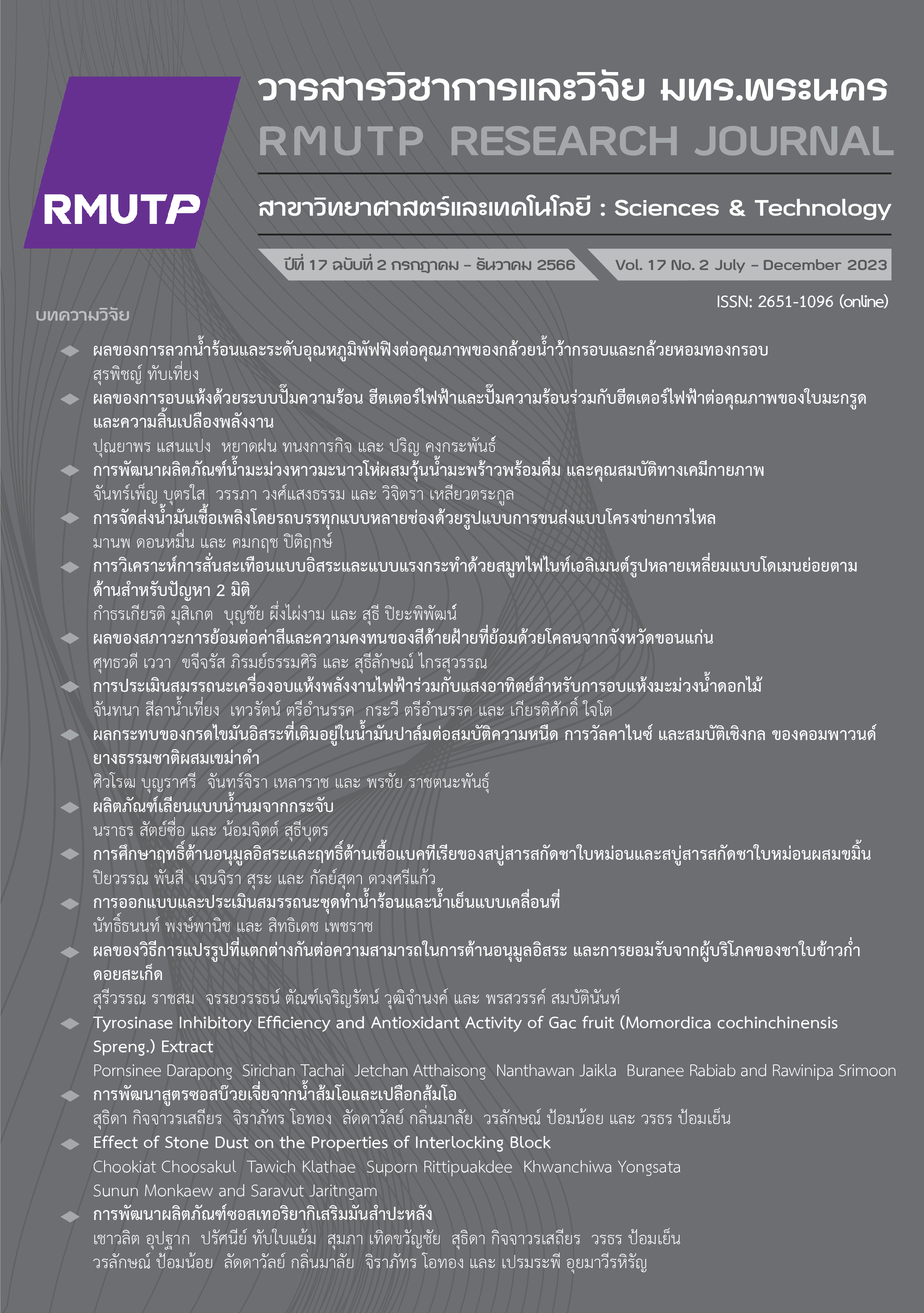Effects of Dyeing Conditions on the Color Value and Colorfastness of Cotton Yarn Dyed with the Mud from Khon Kaen Province
Main Article Content
Abstract
This research aimed to study effects of dyeing conditions on the color and colorfastness of cotton yarn dyed with the mud from Ban Don Makha, Chonnabot Sub-district, Chonnabot District, Khon Kaen Province. Dyeing experiments were conducted using mud content of 100 200 and 300 g per liter of water. Two methods of mud solution preparation used were 1) Mix mud and water then left for 1 hour before dyeing and 2) Mix mud and water then immediately used for dying. After dyeing the color values were measured and the tests for colorfastness to washing, colorfastness to light and colorfastness to abrasion were performed. The results of the study found that after dyeing cotton yarn with the mud, the colors obtained were L* 65.16-69.94, a* 6.09-6.65, b* 12.24-16.73, C* 17.14.-17.93, and h* 68.22-69.77. All dyeing methods yielded the L* a* b* C* and h* values with no significant difference at .05. The colorfastness grades to washing, considered by dE* of color change, were at 2 (poor) to 3 (fair). The colorfastness grades to washing, considered by dE* of color staining, were at 4-5 (good – excellent) for all methods. The colorfastness grades to light were at 4-5 (good – excellent) to 5 (excellent). The colorfastness grades to dry abrasion, considered by dE* of color change, were at 4-5 (good – excellent) to 5 (excellent). And the colorfastness grades considered by dE* of color staining, were at 3 (fair) to 3-4 (fair–good).The colorfastness grades to wet abrasion, considered by dE* of color change, were at 4-5 (good–excellent) to 5 (excellent). And the colorfastness grades, considered by dE* of color staining, were at 3 (fair) to 4 (good). All methods yielded dE* values of colorfastness to washing, to light and to abrasion, with no significant difference at .05. The results of the study pointed out that the optimum condition for dyeing cotton yarn with the mud from Khon Kaen province was using 100 grams of mud per liter of water by Mix mud and water then immediately.
Article Details

This work is licensed under a Creative Commons Attribution-NonCommercial-NoDerivatives 4.0 International License.
ลิขสิทธ์ ของมหาวิทยาลัยเทคโนโลยีราชมงคลพระนครReferences
F. Suree, “Development of natural dyes in upper North region” ChiangMai University, Chiang Mai, .2000.
O. Kulya. “Environmental Chemistry”, 2nd ed. Ramkhamhaeng University, Bangkok. 2004.pp.471-473
S. Darika. “Product development Of Natural dyed fabric,” Faculty of Accounting and Management. Mahasarakham Universit, 2003.
P. Turian. “The comparison of Cationic ions in mud and laterite for an Indigo blue mordant on cotton fiber”. Master's thesis. Sakon Nakorn Rajabhat University, 2008.pp 103.
M. Thiansak. “Chemistry of Natural dyes and dyes”. Science Journal 50. Thammasat University. Bangkok, 1996. pp.155-161.
S. Atcharaporn. “Guide to Dyeing”. 2nd edition. Technique 19 Printing, Bangkok, 1984. 352P. pp. 65-69.
AATCC. 2010. AATCC Technical Manual, American Association of Textile Chemists And Colorists, North Carolina, 28, 107,146
D. Anantachai. Principles of Experimental planning. Department of Statistics, Faculty of Science Kasetsart University. Bangkok, 1997, 348 p.


